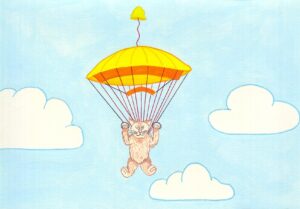 Here’s an idea: Let’s put a bunch of cats on a plane, strap them with parachutes, and dump them off mid-air so they parachute to the ground. Sound far-fetched? Believe it or not this actually happened, and it serves as a lesson in ecology. (Just don’t try this with your own kitty.)
Here’s an idea: Let’s put a bunch of cats on a plane, strap them with parachutes, and dump them off mid-air so they parachute to the ground. Sound far-fetched? Believe it or not this actually happened, and it serves as a lesson in ecology. (Just don’t try this with your own kitty.)
In the country of Borneo, authorities wanted to eradicate the mosquitoes that were spreading malaria. So they sprayed the inside of village huts with DDT. It worked! Cases of malaria plummeted. But there was a problem.
DDT is a chemical that’s very hard to clear from the body. Which means it builds up in an organism and never goes away. If an organism eats DDT, they’ll have it in their system until they die (or are eaten by something else). For this reason it has since been banned in the United States.
Soon after spraying the DDT, the thatched roofs of the huts began to collapse and fall on the people inside. It turns out that moth larvae were eating the roofs and causing them to collapse. Moths and their larvae had always been around, but never in such large numbers. The reason moths were out of control is that the moth’s main predator, a type of parasitic wasp, had also been killed off by the DDT.
That wasn’t the only problem. Cockroaches ate the DDT too, but it wasn’t enough to kill the tough little buggars, whom I’m pretty sure would survive a nuclear apocalypse. Cockroaches laced with DDT, however, were then eaten by geckos. Since geckos need to eat a lot of cockroaches to survive, they accumulated a high concentration of DDT. Remember, DDT never goes away. So every cockroach the geckos ate added a bit more DDT to their body. Still, the tough little geckos managed to survive.
Geckos, however, were eaten by the village cats, who ate lots of geckos, which had much higher concentrations of DDT in their body. Alas, the cats finally started dying from the poison inside their body, since all of this DDT was working its way up the food chain to them.
Once the cats died, the rat population, which had previously been kept in balance by the cats, exploded. The out of control rats were spreading nasty diseases like typhus, leprosy, and the plague, making people sick. Which brings us to the fun part about parachuting cats out of planes.
To fix this problem, the Royal Air Force and World Health Organization were called in to parachute cats into these remote villages of Borneo. The new cats were able to feast on the rats, and eventually all was well in the region. I’m pretty sure they put the cats into crates before pushing them out of the plane, but that’s not as fun as imagining a bunch of tiny little parachutes strapped to cats that are dropping from the sky, mission-impossible style.
The lesson in this story: the web of life is inter-connected, and when something happens to one species it has a ripple effect on others. It’s a cautionary tale for all of us humans who are tinkering with the natural environment. Small changes, or the disappearance of seemingly trivial species, can have a mighty big effect.
